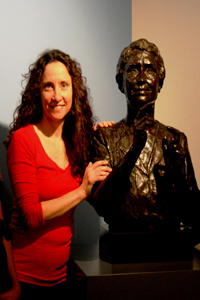[Editor's note: This is the first post in what will be an ongoing series showcasing the Helen Keller Archives, authored by AFB Archivist Helen Selsdon. Stay tuned for more to come.]
My name is Helen Selsdon and I'm the archivist at the headquarters of the American Foundation for the Blind (AFB) in New York City. I came to AFB in April 2002 with the task of taking care of the Helen Keller archival collection. It's been an amazing journey for me, both professionally as an archivist and as a woman to learn so much about this vibrant and commanding figure.
In case you don't know who Helen Keller was, she was born in 1880 in Tuscumbia, Alabama. At the age of 19 months, she became deaf and blind as a result of illness. At the age of 6, a governess came to Tuscumbia to help the family with their "wild child." This woman was Anne Mansfield Sullivan, a firebrand of a personality, who succeeded in communicating with Helen and taught her to speak with her hands and read and write in braille. This relationship is what is often best known about Helen. It was a truly remarkable friendship, but it's just the tip of the iceberg. Helen led a long and incredibly productive life (she died in 1968); as a seminal figure in U.S. history, she met other key players of the late 19th century and the first half of the 20th, and she blazed a trail for all those who are marginalized and demand to have their voices heard. She changed the face of blindness in America and around the globe.
Periodically, I will post an image of one of the 80,000 items in the collection—be it a document, artifact, or photograph. By sharing these items and discussing them, I hope to communicate not only how extraordinary Helen's life was, but also her belief that with hard work and a lot of gumption, one person can truly make a difference.
